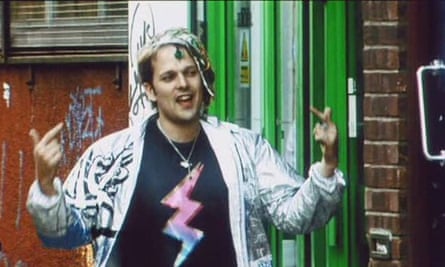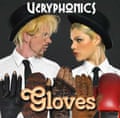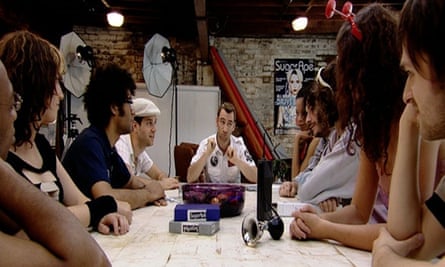At the end of last year, inboxes pinged with news of a person called Shingy, AOL’s new “digital prophet” who travels the world litmus-testing the future, rebooting the CEO’s office by taking out all the chairs and adding a special fragrance called London, and handing out a business card with a microchip in it. In an excruciatingly well-observed – and much-forwarded – New Yorker piece, writer Andrew Marantz detailed Shingy’s comedy haircut, gnomic prescriptions for online success and overcomplicated post-hip-hop handshakes. To American readers he appeared to be only the latest evidence of decadent capitalism’s journey to hell in a handcart powered by bullshit. How is drawing a bear in zebra-print pants worth a six-figure salary? In Britain, though, we reached for the shorthand term we’ve learned to use for this sort of thing: Nathan Barley.
Yes, Nathan Barley, self-facilitating media node, pioneer vlogger and all-round bumptious idiot. Even if you never saw Charlie Brooker and Chris Morris’s Channel 4 sitcom from 2005, which relayed the adventures of a self-designated digital art terrorist in a fictional (but only slightly exaggerated) Shoreditch called the London borough of Hosegate, you’ll be familiar with Nathan and his type. The stupid haircuts, the meaningless catchphrases (“Totally Mexico! Well futile!”), the massive self-regard, the daft fashion statements and the low-level passive-aggressive insinuation that if you don’t get what they’re doing then somehow it’s your fault … these are the hallmarks of the modern creative layabout from Dalston to Williamsburg to Kreuzberg to Nørrebro.
Nathan was conceived in the early noughties as a snapshot of a small and ludicrous slice of east London. He wasn’t supposed to last. But he hasn’t just survived; he’s metastasised. The startups and creative consultancies of every other digital hub from Silicon Roundabout to Silicon Alley resemble nothing so much as Nathan’s world of office juice bars, indoor scootering and open-plan thinkpods, plus vast injections of venture capital cash (the haircuts and low-slung denim are certainly the same). Vice, which provided at least part of the inspiration for Nathan’s odious button-pushing style magazine Sugar Ape, is now a multi-million dollar Murdoch-backed business that carries genuinely dangerous warzone reportage while hanging on to its Barleyite roots. A sample headline: “There’s More To The Duke Of Burgundy Than Lesbians Pissing On Each Other”.
With his relentless sadistic pranks against office assistant Pingu – example: plugging Pingu’s ears into a lorry battery and then uploading video of his wretched twitch-dancing overdubbed with Motörhead’s Ace Of Spades – Nathan established a new normal of online cruelty and self-publicity. From happy slapping to NekNominate to Rude Tube to Vine, anything is permitted now, as long as it fits a 19-year-old idiot’s idea of what’s funny. Brooker and Morris spotted this before YouTube even existed. And Nathan Barley was scarcely less prophetic when it came to TV itself. In one episode Nathan’s friend Claire makes a comically po-faced, self-righteous but secretly rather narcissistic documentary about a choir made up of drug addicts. Nine years later, Channel 4 made Addicts’ Symphony for real.
Looking for an online guru with an open-ended nanofesto that boils down to “peace and fucking – believe!”? Sorry Russell Brand, Nathan beat The Trews to the punch by 10 years with the rambling video homilies on his website (back when websites were novel) trashbat.co.ck. Barley aficionados will surely see in Brand some echoes of the show’s Preacherman character, the burnt-out style writer Dan Ashcroft who is bullied by style mag Sugar Ape’s appalling editor Jonatton Yeah? into adopting a voice-of-a-generation role. Replace the cynical weariness with messianism and you have Russell to a tee. Brand connoisseurs might also enjoy the episode in which Nathan copies a truly asinine haircut made up of paint and bottle tops and random gloop – the Geek Pie as it is known – and then peacocks around Hosegate pointing at it and crowing, “New fucking paradigm or what?”
From cereal cafes to breakfast raves to adult ball pools, from TV shows like Sex Box to newspaper features about the “meaning” of the Man Bun hairdo to inexplicable online phenomena like Ello, our world has been Barleyed. It is uncanny. Created as a comic figure, Nathan has become an insult and a signifier and maybe even – here’s the frightening part – a role model. At 10 years’ remove the show seems less a comedy and more a documentary about the future.

“Back when we were shooting it,” says the actor Nicholas Burns, who played Nathan, “I remember one producer saying, ‘This show will date terribly. In three or four years it’ll look awful.’ But watching it again, you see how prescient it was. It really is the world we live in now. A friend who lives in Dalston told me they saw someone riding a penny farthing the other day. It’s unbelievable really.”
As someone who once saw a fixed-gear cyclist bombing down Stoke Newington High Street in a GENERAL PINOCHET T-shirt, I am inclined to agree.
It is sobering to think that it’s fully 10 years since Nathan’s TV debut late on Friday 11 February 2005, and more sobering to reflect on how little has changed. We call them hipsters now, and they’ve got beards, but in every other respect the Barleys are unaltered. “The anniversary makes me feel fucking ancient,” says the show’s co-creator, Guardian columnist Charlie Brooker. “It’s actually even longer than 10 years, because Nathan started life on the TVGoHome website.”
TVGoHome was Brooker’s surreal and scatalogical late 90s collection of fake TV listings, including imaginary shows such as Inspector Bumhat, Daily Mail Island and the probably-best-not-explained Mick Hucknall’s Pink Pancakes. It now reads like a cross between an Alan Partridge “monkey tennis” blue-skies idea session and a howl of existential despair. “I had to stop doing TVGoHome,” Brooker admits, “because the real TV programmes were becoming more stupid than any I could make up.” One regular listing concerned a young media man about town called Nathan Barley. It went under the pithy title of Cunt.

“When he started out, Nathan wasn’t what we’d now call a Shoreditch hipster,” Brooker says. “I’d never even been to Shoreditch. It was more about moneyed young guys who claimed to be working in television when really they were living off their parents. He was more of a Made In Chelsea figure, and he kind of morphed into a Hoxton idiot for the TV show.”
Chris Morris, the creator of The Day Today and Brasseye, had written listings in secret for TVGoHome. Around 2000 he suggested that they try to develop a show around the Nathan character and east London’s increasingly absurd club/art scene. “We talked about the show for years before we made it,” says Brooker. “Chris was adamant very early on that there should be a tiny acorn of likability to Nathan, something irrepressible. He does terrible things but he has an endearing sort of rabbity enthusiasm to him. In the fake listings he really was a cunt, whereas in the TV show he’s a twat – and there is a difference.
“Nick Burns was one of the first people we saw for Nathan, and he was just very funny from the start. He could pull off a preposterous swagger that was both enjoyable but coming from a place of massive insecurity.”

Rather than scripting a series, they created characters with the actors in seemingly endless workshops, then built stories for six episodes around Nathan, the jaded hack Dan Ashcroft – played by Julian Barratt of The Mighty Boosh — plus his bad-tempered film director sister Claire (Claire Keelan) and the nightmarish editor Jonatton Yeah?, played by Charlie Condou. The work was so piecemeal and unstructured that even the actors didn’t know what was really happening.
“I remember asking Richard Ayoade [who played arch-idiot Ned Smanks], Have we got this? Are we actually doing it?” says Condou, who later found more mainstream fame as Coronation Street’s Marcus Dent. “He had no idea and nor did I.”
Of necessity there were research trips to Shoreditch and Hoxton, then far from the gentrified locales they are now but already testing the limits of stupidity. Material seemed to fall into their lap, like the Vice party where they burned all the mainstream magazines on a bonfire. Or the pub that had been bought out by club promoters, but “to confuse people” they’d kept the downstairs bar unaltered and given all the regulars membership. “All the normal people had been turned into these weird props.”

One evening Condou met Tracey Emin at a party the Pet Shop Boys had thrown at Sam Taylor-Wood’s studio on Redchurch Street. He told Emin how sorry he was to hear about the recent fire that had destroyed all her work. “She just looked at me and went ‘meow’. I was so taken aback. Did she just meow at me? Did that happen?” The next day he told Brooker and Morris about it. “We’re having that,” they said.
What had begun as Nathan’s story slowly evolved into the tale of Dan Ashcroft’s building animosity towards this apparently indestructible style goon, who couldn’t help succeeding no matter what he did. Even when Nathan makes a total fool of himself with the Geek Pie haircut – and for once we feel rather sorry for him – there’s a Japanese TV crew nearby to decide that he’s inaugurated the new wave of hair statements and anoint Nathan as a style leader. Some universal law would operate in his favour. “Chris kept telling me, ‘Nathan always wins’,” says Burns. Dan, meanwhile, begins to circle the plughole of his own resentment in what begins to feel like The Day Of The Locust in dragon-print Maharishi pants.

Watching Nathan Barley now, the surprise is not just how durable the material is. It’s the quality of the cast. The show is full of future stars, sometimes in tiny roles. “Because of Chris and The Day Today, everybody wanted to be in it,” says Burns.
Nathan’s assistant-victim Pingu is played by Ben Whishaw, now Q in the Bond series, who in Nathan Barley scarcely says an intelligible line. Stephen Mangan appears for mere seconds as porn star Rod Senseless, yelling – and doing – jaw-dropping stuff that would put his Episodes audience in therapy. And the panicking finance director who tries to stop futurist-poseur Doug Rocket (a very thinly-veiled Dave Stewart from the Eurythmics) from squandering yet more millions on his preposterous arts lab, Place., is played by Benedict Cumberbatch. It is like watching George Clooney play a binman. “There are whole conversations with Cumberbatch that we didn’t use,” says Brooker. “Hours of it. The cast we got was insane. I’ve got hours of rehearsals on VHS somewhere.”
Yet Nathan Barley was not a success on its first transmission. Ratings began at 1.2m but dropped to a poor 700,000 for the final episode. The decision to show a comedy about clubbers, druggers, posing scenesters and dreadful DJs on a Friday night – when its core audience was out clubbing, taking drugs, posing on their various scenes and listening to dreadful DJs – was probably not the wisest.
In the Guardian the show was denounced as “five years too late … woefully out of touch” by Neil Boorman of the Shoreditch Twat, a fanzine aimed at real-life Barleys who possibly missed the point that Nathan Barley wasn’t supposed to be a scrupulous reflection of Hoxton groovers but a surreal tweaking of their world. Despite the poor ratings, the people who liked the show really liked it, and talked about it long after it ended.
“We’d been told this show would only be of interest to five people in London,” says Brooker, “but we thought there were probably Nathans – annoying, show-offy idiots who sometimes/always get away with it – back in the 4th century. He’s a type.”
First DVD and then 4oD gave Nathan Barley an afterlife. “Well Jackson”, “keep it dense” and Nathan’s other vacuum-brained slogans began to enter the lexicon as ways to show that you fully understood the idiocy of any brave and edgy proposal before you. Nathan Barley is now mentioned every single day on Twitter, usually with reference to some new development in tech or fashion. “And I don’t think a day goes by without somebody shouting ‘Totally Mexico’ at me in the street,” says Burns. “Nathan was the best thing I’ve ever been involved in. I’d play him again without a second’s thought.”
Despite the low ratings there was, at some point, going to be a second series. Brooker, Morris and the cast workshopped scenes in which Nathan’s parents staged an intervention at last, cutting off his money and sending him to rehab. Sugar Ape magazine would close down and become a website after the editor Jonatton Yeah? realised it was selling no copies whatsoever. The cast would end up living far from the bright lights of Hosegate in dismal suburbia, with Nathan’s brother, a terribly straight doctor who was going through a hellish divorce. “The basic cast are now adrift,” is how Brooker describes it, “and Nathan is starting to worry that he’s old and maybe slightly irrelevant.” One storyline entailed him attempting to DJ at an NCT class.

But Morris had become more interested in developing his Islamic fundamentalist comedy Four Lions and Brooker’s TV career took off, first with Screenwipe and then Dead Set and Black Mirror. The first series of Nathan Barley had begun without any of the core cast realising they had actually started work on a TV show; the second faded away in much the same manner.
Nevertheless it’s tempting to wonder what these characters would be doing now. Nathan would have surely eased into the world of Vines and branded content, Brooker thinks, or perhaps would run some non-specific imagineering department of Google. Burns wonders if Nathan would have had some religious breakdown and gone to get his head together in the country, a locavore diet and low-carbon lifestyle being the guilt-ridden choice of many a former urban hedonist. “They’d all have children with stupid names by now,” he says. “What a horrible thought.”
Jonatton Yeah? would doubtless be running some nonsensical creative consultancy. Claire Ashcroft would probably have succeeded as a film-maker and then become a commissioning editor every bit as shallow as the ones she encountered in Nathan Barley. As for her journo brother Dan, “he’d either be dead or finally writing restaurant reviews for Weekend on Sunday magazine,” Brooker suspects. “For the second series we thought about having Dan trying to write a novel and working as a minicab driver. Nathan infuriates him by writing a novel in three weeks. But Pingu, I like to think, would have inadvertently made more money than any of them, from some app or other. The shoe would definitely be on the other foot. That’s a comforting thought.”

And there is another comforting thought about Nathan and his world. However vapid and silly and self-congratulatory he was, in his own way Nathan was almost an idealist. He and his mates represent the twilight of the style mags, the last days before you needed well-heeled connections and independent means to make it into the media. And you never hear anyone at Sugar Ape wanting to energise the content space for maximum brand engagement.
“You can laugh at the Sugar Ape team, and they are moronic,” says Steve Beale, founding editor of the late style magazine Sleazenation and subsequently business director at Lazarides Galleries. “But at least they were doing it for the sake of expressing themselves. Back then, the style media was a way into journalism for young talent from outside London. It was feasible then, but that door has totally closed now. Who can just move into Hoxton Square on spec now? Today the media is just a career option for Head Boy and Head Girl types. Talent without connections and money just can’t get a look in.”
Perhaps this is why Nathan Barley fans can still watch the show with affection. It is both an alternative vision of now and an image of the way things used to be, when you really could just ride into Shoreditch on a plastic tractor with a tiny bowler hat on your head and start some kind of a career. Things are less forgiving today.
But we are all self-facilitating media nodes now, if only because we all hoot our opinions into the void of social media, vainly looking for affirmation. “Nathan will just not die,” says Burns, “and that’s pretty Nathanic in itself. Whatever happens, someone like him always comes out on top.” The idiots will always win, because maybe – like Shingy – they’re actually smarter than you think they are. The future is now, and it’s ridiculous. So why fight it? Instead let’s raise a glass of Dutch wine to a character who is, in his own appalling way, a kind of hero. Keep it dusty, you bum pilots.

Comments (…)
Sign in or create your Guardian account to join the discussion